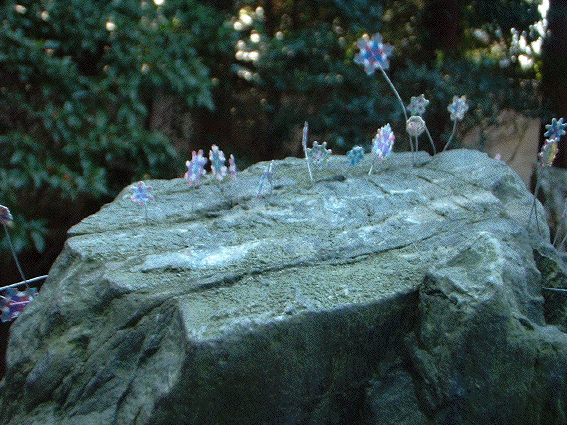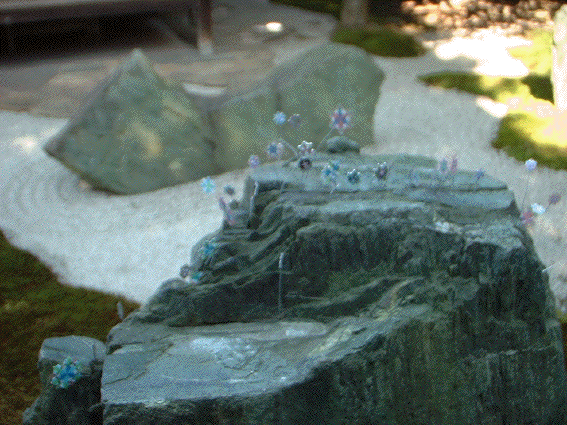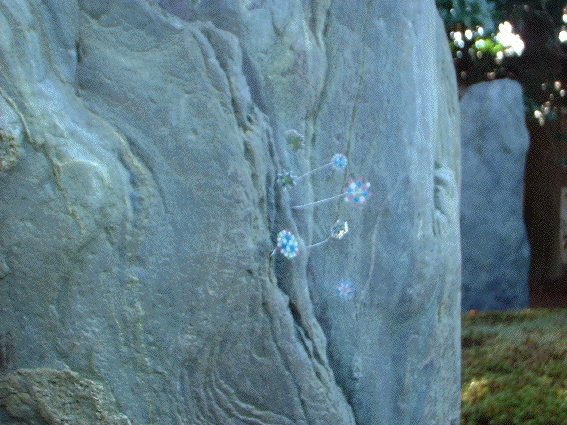
2nd - 28th February 2001
Shigemori Residence, Kyoto
Installation view



To Fall, To Dive For more installation views click
Korean artist, Koo Jeong-a has been based in Paris for ten years. During this time she has assembled around her an intricate private world, often created from memories of her home country. Her work is typically composed of fragments and refuse arranged in fragile and ephemeral configurations which displace conventional modes of display found in galleries and museums. The idea of an 'abstract house' can be identified within many of Jeong-a's semi-architectural constructions, a concept that avoids exoticism, drawing instead upon the everyday.
For her project, Koo Jeong-a visited many temples and their gardens in Kyoto as well as spending considerable time at the Shigemori Residence. Of particular significance was the Horyu-ji temple (607) edified at Ikaruga in Nara which had an identical Korean counterpart later destroyed by fire, a place where she could refer (or imagine) Korean-Japanese relationships across the sea of that time.
Within the garden of the Shigemori residence exists a stone plateau. The beautifully proportioned stone is a remnant of the Shinto order, Suzuka, which used to inhabit the house before it was purchased by Mirei Shigemori. Until comparatively recently, this symbolic stone was considered the site of divinities. It will be at the centre of Jeong-a's installation.
In Korean, 'private garden' also translates as 'uterine space' and thus relates to Jeong-a's concept of the 'abstract house'. Inspired by this association, Jeong-a has decided to create an architecture of thin steel wire tracing the Shigemori garden. This fragile construction will float like a chimera between the garden's stones hovering on the edge of invisibility. A kind of meta garden, Jeong-a's intervention engenders an interpretative space in which the garden can be reflected upon as a "uterine" space.
In her project 'To Fall, To Dive', Jeong-a wishes to elicit the viewer's imagination and to draw upon both the individual and collective memory of the garden; a place that for her seemed strangely silent and mute in the absence of ritual.
dialogue : Koo Jeong-a (artist) Nathalie Viot (art critic, independent curator)
moderator: Mitsuaki Shigemori (artist, shima co-curator)3rd February 2001 6 pm - 8 pm
Villa Kujoyama
17-22 Ebisudanicho Hinooka Yamashinaku Kyoto
Tel. +81 (0)75 752 7171The intention of the seminar is to consider some of the many implications raised by the Japanese landscape garden as architecture and microcosmos. The seminar considers 'Shima' as a series of parallel investigations, focusing particularly on the contribution of Koo Jeong-a. Potential subjects for discussion include: artificial nature (the garden as artifice and model), in-betweeness (between garden and architecture, inside and outside space), micro/macro (the garden as microcosmos), framelessness (order and contingency within the garden) and life/locus in Art (wholeness and the implicate order).
Mirei Shigemori Residence
34 Kamiojicho, Yoshida Sakyoku, Kyoto 606-8312, Japan
Fax +81 (0)75 761 8776 E-mail shima753@hotmail.com
Due to limited access by appointment onlywith the kind support of Institut Franco-Japonais du Kansai, Japan Arts Fund, Shiseido, AFAA,
Service Culturel de L'Ambassade de France au Japon, Alliance française d'Osaka and Galerie Yvon Lambert, Paris
home | site | project | seminar | association | map | contact |